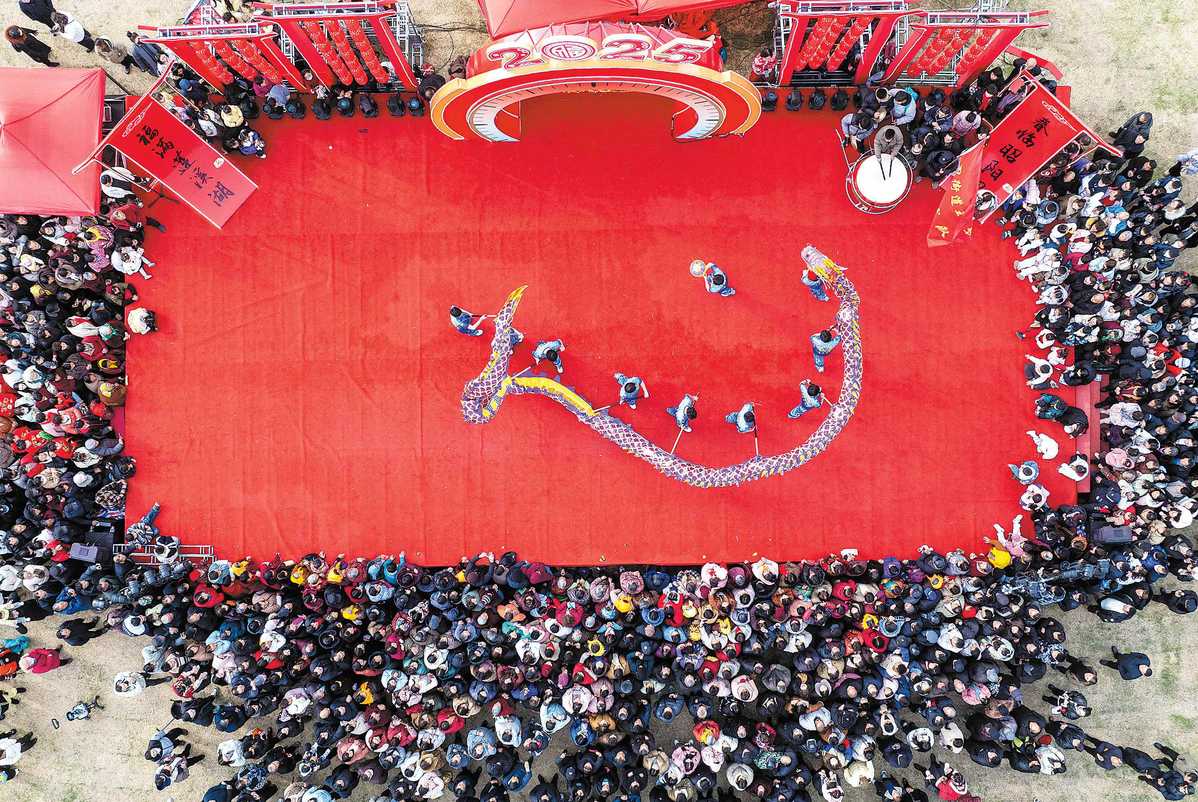
Residents watch a dragon dance performance in Xinghua, Jiangsu province, on Sunday during Spring Festival celebrations. Various events, including folk activities and intangible cultural heritage displays, have been held across China to celebrate Spring Festival. Zhou Shegen / XINHUA
Surrounded by crowds and patting the head of a fish-shaped lantern for good luck, 27-year-old Tian Jialiang immersed himself in the rich, festive vibes of Spring Festival in Zhanqi village of Shexian, Anhui province.
Tian, who is a native of Nanchang in the neighboring province of Jiangxi, was on a four-day self-driving tour to Huangshan, Anhui, with four friends.
"Spring Festival is one of the most important traditional holidays to the Chinese people. We came here for the village's strong new year atmosphere and celebrations, where the performers mimic fishes' movements to bring good luck and fortune. I think it is the essence of the festival," Tian said.
Spring Festival, which was added to UNESCO's Intangible Cultural Heritage list in December, has seen people's passion skyrocket for tourism destinations highlighting cultural vibes or folk customs.
This year's Spring Festival fell on Jan 29, the first day of the first month of the Chinese calendar, and marked the beginning of the Year of the Snake. People in China enjoyed an eight-day break, from Jan 28 to Tuesday.
Reports from travel agencies showed that cultural tourism destinations were in vogue during the holiday.
Travel portal Qunar said that cities with festive celebrations or folk customs, including Huangshan in Anhui, Chaozhou and Shantou in Guangdong province, and Quanzhou in Fujian province, were among the most sought-after destinations by its users during the holiday. These places are well known for folk events, including fish-shaped lantern shows, lion dances and hairpin flowers.
Huangshan saw its hotel room bookings double year-on-year during the holiday.
Another travel portal, Fliggy, said travelers have shown an increasing interest in immersive tourism events featuring Chinese cultural elements, including visiting temple fairs, wearing traditional Chinese hanfu attire for photo shoots, and appreciating lantern shows. It said that sales of tourism products related to folk custom performances grew 36 percent year-on-year on its platform.
Liu Gengshuo, 30, who is from the northeastern province of Jilin, booked photo-shooting services featuring traditional hanfu clothing for his wife in Datong, Shanxi province, for the Spring Festival holiday.
"It has long been our wish to embrace Chinese New Year in Datong, a city that enjoys a long-standing history and is home to much historical architecture, including temples," Liu said. "The city is filled with a festive atmosphere and beautiful decorations. We will come again for another visit."
Qi Chunguang, vice-president of online travel agency Tuniu, said the addition of Spring Festival to UNESCO's Intangible Cultural Heritage list has greatly increased people's enthusiasm for traditional Chinese culture, and this turned places with intangible cultural events into hot tourism destinations over the holiday period.
Some history and culture museums have also been popular, Qi said.
"People have shown great demand and interest in high-quality travels, as they wish to explore the destination's cultural and social practices with immersive events. I think the trend will keep the tourism industry developing this year," he said.
Chinese travelers also showed strong consumption power and a desire for overseas tourism destinations during the Spring Festival holiday. Figures from Fliggy showed that international cruise bookings surged 229 percent at its platform for the holiday period, and overseas destinations such as the Hong Kong and Macao special administrative regions, as well as countries in Southeast Asia, were top choices for people from the Chinese mainland.
Cai Muzi, an analyst at travel portal Qunar, said that Thailand continues to rank near the top of Chinese people's favorite overseas destinations because of the shorter travel hours, visa-free policy, milder climate and cheaper travel costs.
According to Qunar, Chinese travelers set foot in more than 2,100 cities worldwide during the holiday, with the number increasing 50 percent year-on-year. In addition to Southeast Asian countries and regions, destinations in Europe, the Middle East and Africa, ranging from Hungary and Norway to Saudi Arabia and Egypt, saw an increase in tourism visits by Chinese.
chengsi@chinadaily.com.cn
Zhu Xingxin in Taiyuancontributed to this story.